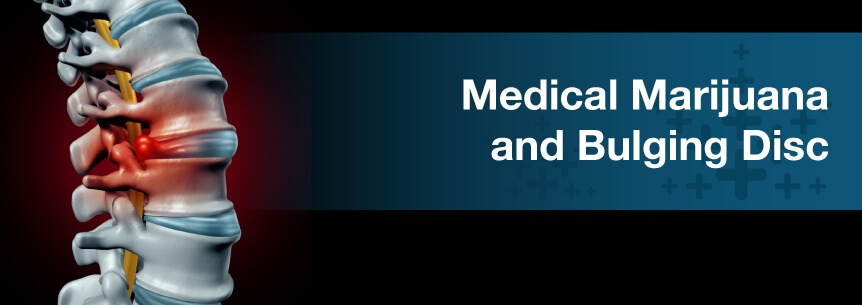
Back pain is quite common as up to 80 percent of individuals experience it sometime in their lives. It’s a significant reason why many people miss work and see the doctor. In fact, back pain is the number one reason people go to their doctors.
One of the leading causes of back pain is a herniated or bulging disc. These are often recurrent and disabling, especially for those who lift heavy things frequently. Treatment for bulging disc back pain can be dangerous and ineffective. Despite taking addictive pain medications or having complicated surgeries, many individuals don’t experience the relief they need. Fortunately, medical marijuana is available as a treatment for bulging disc pain and could provide you with relief and comfort.
If you’ve received a bulging disc diagnosis, you’re not alone. It’s common in athletes and prevalent in the aging population. While some bulging disc conditions are asymptomatic, they can lead to discomfort and disability in numerous areas of your body if the disc compresses the spinal cord or a neighboring nerve root.
A bulging disc occurs when your disc between your spine’s vertebrae shifts outside the area it’s supposed to be in or ruptures. It’s often confused with a herniated disc because of their similarities, but they are different conditions.
A bulging disc most often occurs in the lumbar region or the lower area of your back.
When you first develop a bulging disc, you might not notice it right away because it’s not touching any nerves. However, you may experience a certain sensation in your leg and buttocks with a bulging lumbar disc, known as sciatica. These sensations include:
Discs act like a cushion between your spine’s vertebrae. They’re made up of a tough outer layer of cartilage, surrounding a softer type of cartilage in the center.
With age, discs begin showing signs of wear and tear. A bulging disc won’t move back into place by itself, and, as your body begins aging, the disc tissue will start becoming less flexible and drier, intensifying the painful effects.
As discs dehydrate, the cartilage begins to stiffen over time. Because of this, your disc’s outer layer bulges out evenly around its circumference. Think of it as a big hamburger that’s too large to fit its bun.
Knowing what the cause of your bulging disc is can help you prevent the pain and other symptoms it produces. When the fibrous outer containment ring weakens, it can cause the disc to bulge. This weakening is unavoidable since it is often age-related. Other factors contributing to or causing a bulging disc include:
However, certain activities can expedite disc bulge development, and you should avoid them. You can discuss these activities with your doctor. Other things you’ll want to do include:
Bulging disc symptoms typically start emerging only when the disc puts other issues into motion. The symptoms or signs of a bulging disc depend on where in your spine it is:
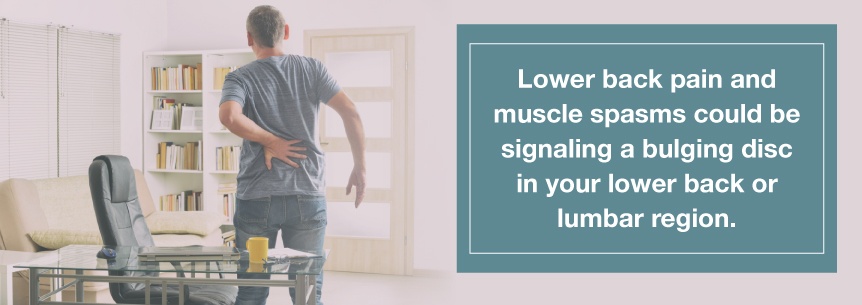
In some cases, this discomfort can spread to your thighs, buttocks, and feet. Sciatica results when the bulging disc is pressuring the sciatic nerve. This condition typically presents itself as pain spreading down one leg only. If you lose control of your bladder, get medical attention right away since this could indicate the bulging disc is pressing on your cauda equina nerve bundle.
Bulging discs can occur anywhere along the 24 vertebrae making up your spine.
A cervical spine bulging disc can develop at any vertebrae composing your upper spine — referred to as C1 through C7.
This type of bulging discs may cause symptoms like:
These feelings may radiate through your shoulders, neck, fingers, hands, and arms. Cervical bulging discs may also cause myelopathy spinal cord injury, causing a group of symptoms like loss of fine motor skills, difficulty walking or heaviness in your legs.
Your thoracic spine spans to the end of your rib cage from the collarbone. It contains 12 vertebrae referred to as T1 through T12.
While bulging discs don’t usually occur in this area, they may cause upper back pain radiating to your chest or stomach.
Often, symptoms of thoracic bulging discs aren’t diagnosed correctly and are often confused with lungs, heart or gastrointestinal problems. Because of this, it’s important you consult with a specialized doctor promptly to receive a correct diagnosis.
Lumbar spine bulging discs can develop through your L1 through L5 vertebrae spanning to the top of your hips from your waist.
Bulging discs often occur in this area and may cause symptoms like:
While there’s usually little to no pain arising from a bulging disc, the disc affected could suffer a herniation eventually. This means its inner nucleus could begin leaking through the damaged shell, causing pain and other complications.
A bulging disc could also place pressure on neighboring nerves, resulting in serious discomfort or even chronic, severe pain in some cases.
The most common symptoms of bulging discs are:
Many people with chronic back pain experience depression. Experts believe major depression is up to four times greater in individuals who have chronic back pain than it is in the general population.
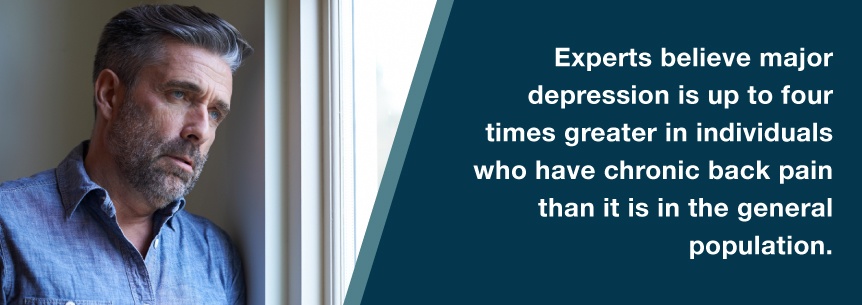
A 2016 study investigated the prevalence of anxiety and mood disorders in patients experiencing chronic lower back pain due to disc herniation. Results from this study showed:
The study showed anxiety and mood disorders are seen more commonly in cervical or lumbar disc herniation than people without herniation.
Facts about bulging discs include:
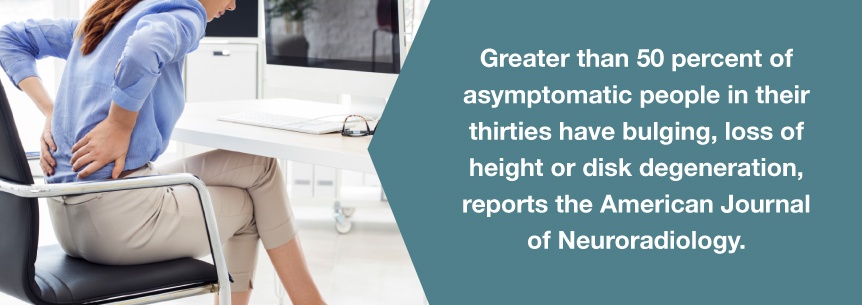
The first sciatica descriptions go as far back as ancient times. However, our knowledge of lumbar disc herniation (LDH) being a clinical condition first came about in the mid-1700s. While surgeries on spinal “enchondromas” — most likely they were herniated discs — took place in the 20th century, Mixter and Barr were first to perform modern discectomy surgery in the 1930s.
From the 1930s through the present day, our knowledge and understanding of the natural history, pathophysiology, and treatment of lumbar disc herniation are continuing to grow more sophisticated. Around 200,000 discectomies were performed in the U.S. annually by the mid-1990s. There’s still debate over the best treatments for LDH patients, despite its frequency.
Several treatment options are available for treating bulging discs. These include:
Numerous alternative and complementary treatments exist that could treat back pain effectively. These include:
Some herbal supplements with anti-inflammatory properties could help alleviate back pain as well. Many patients also claim cannabis helps treat their back pain effectively.
Newer technology exists to help ease sciatica and back pain that disc problems cause. Intradiscal Biacuplasty (IDB) is an innovative and advanced form of radiofrequency ablation used for treating discs from the inside.
Nucleoplasty is a form of Radiofrequency Discal Procedures where the doctor inserts an extremely thin needle into your disc, using a special radiofrequency probe they insert into your disc through the needle. Previously, they would use a heating wire.
The probe produces a highly targeted plasma field consisting of enough energy to break the nucleus gel’s molecular bonds up. This vaporizes some of the nucleus. After the procedure, the doctor removes around 10 to 20 percent of the nucleus that decompresses the disc, reducing the pressure on surrounding nerve roots and the disc itself.
Patients often claim medical cannabis relieves their bulging disc symptoms better than prescription medicines and has substantially fewer side effects. Two of marijuana’s main medicinal ingredients, CBD and THC, have already been shown to relieve pain and have anti-inflammatory properties.
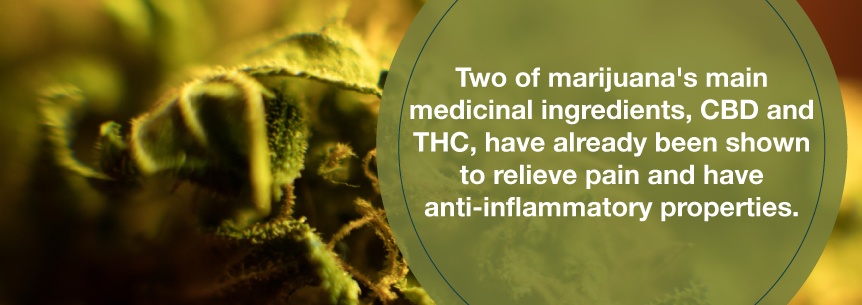
Marijuana for bulging disc also has certain beneficial effects for treating back pain such as:
Cannabinoids might also be useful in treating nerve injury pain.
The Institute of Medicine (IOM) issued a report in 1999 discussing how medical weed contained cannabinoids that helped treat neuropathic and acute pain, especially post-operative and spinal cord injury pain. The report also discussed how nervous system cannabinoid receptors can detect and manage the perception of pain. The report shows medical pot works effectively due to its analgesic properties.
Cannabis for bulging disc treatment effectively treats the associated symptoms of:
These are some good marijuana strains for bulging discs because they not only ease the pain associated with bulging or herniated discs but also treat other symptoms like nausea, insomnia, inflammation, stress, and depression:
Popular medical cannabis strains to treat muscle spasms include:
Today, medical weed makes a good alternative to pharmaceutical medications that come with potential adverse side effects and serious addiction. Often, marijuana can treat inflammation and pain and improve the quality of life better than traditional medications. You can use cannabis topically or internally for the relief of your symptoms.
Common medical marijuana delivery methods are:
Because it can affect the respiratory system, smoking marijuana isn’t recommended, especially for those who have lung conditions. Therefore, other methods, such as edibles, balms or tinctures may be more suitable.
If you’re struggling with bulging disc back pain and other symptoms and would like more information about how medical marijuana could help, book an appointment with a qualified medical marijuana doctor or search for a dispensary. MarijuanaDoctors.com is dedicated to improving your quality of life.
Find A Doctor Find A Dispensary